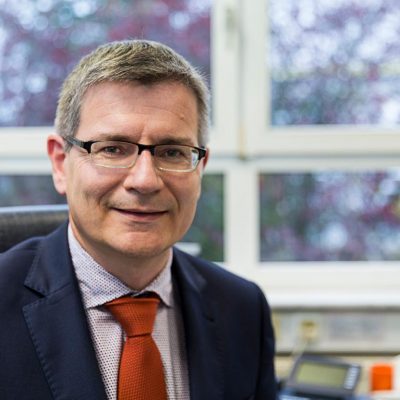Company
EyeSense was founded in 2006 as a spin off of CIBA Vision, a subsidiary of the Novartis Group. As early as 2007, successful clinical trials were being performed with the first eye sensor prototypes. Further studies and product improvements were carried out until 2010. The eye sensor is currently at an advanced prototype stage. Since 2010, we have concentrated our efforts on the development of a continuous glucose monitoring system. In 2011 and 2012, two successful clinical trials were conducted using prototypes for the CGM System. Since 2013, EyeSense has been working to bring the CGM System to series production status. In 2017 two more successful clinical trials were conducted using close –to-production prototypes also under home use conditions.
Team
Management

Dr Achim Müller, CEO
Achim Müller is a macromolecular chemist by training. He has worked in the field of research and development for over 25 years. He has led many interdisciplinary, international research and development projects. He successfully headed the research and development department of a strategic business unit at CIBA vision, one of the leading contact lens manufacturers worldwide.
Achim Müller is the inventor and co-inventor of over 276 patents and patent applications which have contributed greatly to highly successful products on the market.
Since 2006, Achim Müller has been CEO and Chief of Development at EyeSense GmbH, in 2010 becoming the sole CEO.
“It is an extremely satisfying experience to accompany a product from its birth in research along the path to its commercial launch, all the while contributing one’s own ideas and creativity. And when that product has the potential to help patients with chronic disease, it is a privilege.”
Reliable and experienced chemical laboratory staff help support our development team.
Additionally, EyeSense collaborates with numerous external partners from the fields of biotechnology and electronics/optics.
Further applications
Full implant
Through its work on conjunctive implants, EyeSense has already laid the groundwork for a full-implant glucose sensor. This makes contact-free blood glucose measurement possible by using the tissue fluid under the Skin.
In order to monitor blood glucose in particular, a biochemical sensor is used that reacts reversibly to glucose concentration, emitting varying fluorescence intensity as corresponds to the glucose concentration measured.
The sensor is placed under the uppermost skin layer (subcutaneous) by a physician. The insertion is painless and takes only three minutes. The size, location and material of the mini sensor are specially selected to avoid the feeling of a foreign object. The sensor can be worn for up to one year before being replaced. During this period, a small monitoring hand device is used for blood- and touch-free glucose monitoring. It emits light onto the sensor and reads out the returned optical signal sent by the sensor. Once the device is calibrated, the results are expressed in the usual blood glucose measuring units. One individual measurement takes only a few seconds.
Future potential: Bioreactor - Intravenous - Cell culture
Glucose sensors can not only be used to determine blood glucose in the medical field, but can also be used in biotechnology to determine the glucose concentration in bioreactors or cell cultures. This makes it possible to improve regulation of biological processes in bioreactors as well as to screen cell cultures efficiently.
Along with the use of continuous glucose monitoring sensors for diabetes patients, glucose monitoring can also be useful in intensive care units. Studies prove that wounds heal best post-operatively when blood glucose values are well-regulated. This is true for diabetics and non-diabetics alike.
Currently, intensive care nurses have to conduct blood glucose measurements repeatedly and in regular intervals throughout the day. This constitutes a considerable burden for nurses and for health insurance providers in terms of time and cost. Automatic monitoring systems would thus save on both.


